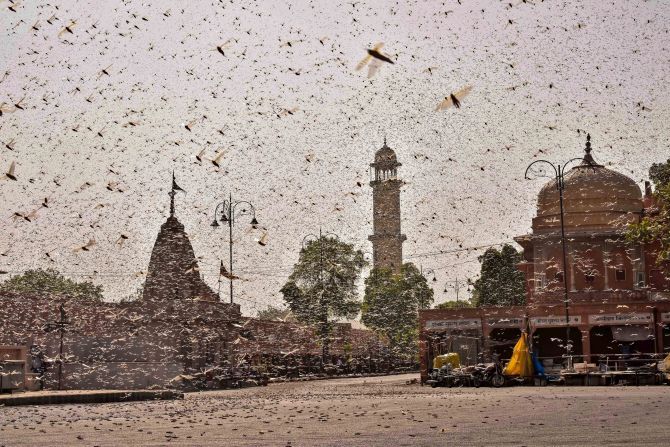 | « Back to article | Print this article |
The locusts initially entered Rajasthan from Pakistan and from there the swarms moved towards Madhya Pradesh, Haryana, and Punjab over the last few weeks and are now threatening to enter Uttar Pradesh, putting at risk the summer crop.

After entering Rajasthan's capital Jaipur on Tuesday, swarms of locusts have now made their way towards Uttar Pradesh, putting on alert almost 10 districts in the state in what some people are terming as the worst such attack in more than two decades.
In neighbouring Madhya Pradesh, farmers said the locusts could have an adverse impact on the yield of their standing summer moong crop, which has been sown in record areas this year.
The locusts initially entered Rajasthan from Pakistan and from there the swarms moved towards Madhya Pradesh, Haryana, and Punjab over the last few weeks and are now threatening to enter Uttar Pradesh.
In Madhya Pradesh, the locusts have hit the summer mung crop planted along the Narmada-river belt while in Uttar Pradesh there are initial reports of damage to some vegetables.
Data shows summer pulses, which largely consist of moong, have been sown in about 0.87 million hectares this year, which is almost 61 per cent more than the area in the same period last year. A significant quantity of this increased area has been in Madhya Pradesh and Uttar Pradesh, where summer moong is grown in large quantities.
In Rajasthan, where the attack originated and is among the fiercest, officials said so far the swarms have stripped the trees of their leaves as there is not much standing crop on the ground.
“In Madhya Pradesh, locusts have hit the districts of Sehore, Nasrullaganj, Harda, Dewas, and Khategaon where they are feeding on the standing summer moong crop. The attack happened just when farmers were preparing for a good harvest of moong due to adequate soil moisture,” said Bhagwan Meena, founder, and spokesperson of Kisan Swaraj Sangathan said.
He said though the state government has issued several advisories, it still had to show some results on the ground.
The United Nations Food and Agriculture Organisation (FAO), meanwhile, last week warned of several waves of attacks at least until early July.
FAO in its latest report said as vegetation dries out, more swarms would form and move along both sides of the Indo-Pakistan border.
Locust attacks in 12 countries, including Pakistan, Iran, and ten nations in Africa, have damaged crops over millions of hectares since 2019. Countries in Africa and West Asia have been battling swarms of locusts since December.
"The locusts usually breed in areas surrounding the India-Pakistan border in the summer months of May and June and then move in swarms which is gradually brought under control, but this time the swarms have splintered into multiple groups which are moving towards MP and UP thereby making their control difficult," a senior official from Locusts Warning Organisation (LWO), Jodhpur told Business Standard.
He said unlike winters, locusts are highly alert in the summer months and can fly away at slightest noise, which is why controlling them is a big challenge.
"Spraying chemicals over a large area through drones or helicopters is viable option but the menace can also be controlled by making sound and noise locally as the pests are highly sensitive to sound," the official said.
Meanwhile, in Uttar Pradesh, a senior official told news agency PTI that in the affected districts administration has been put on alert and asked to remain prepared with chemicals in tractor-mounted sprayers, power sprayers and fire brigades, and undertake heavy spraying during the night.
Besides, local villagers have been asked to make noise by beating 'thalis' and bursting crackers to drive away a locust swarm.
He said a swarm of locusts was seen in the jungles of Jhansi on Sunday and 40 per cent of it was destroyed after chemicals were sprayed by state and central government teams.
Due to the wind direction, there was a threat from this swarm in Mahoba district, which was put on high alert, he said.
There are reports of partial damage to vegetables in 25 hectares of area and a detailed inspection of the extent of loss is being done. Another swarm, the official said is active in Karauli in Rajasthan, following which an alert was issued for Jhansi, Lalitpur, Jalaun and Auraiya and their adjoining districts like Hamirpur, Kannauj, Etawah and Kanpur Dehat.
In Rajasthan, the menace has now spread to almost 18 districts of the state. This is the second locust attack in India in the last one year. The first one happened between December to February destroying crops in Rajasthan and Gujarat.
In Rajasthan, locusts normally affect districts in western Rajasthan but this time the swarms have travelled as far as Jaipur city.
The swarms later headed towards the Dausa district.
The last such attack occurred on April 11 when the swarms entered from Pakistan and damaged cotton crops in Ganganagar to some extent.
Meanwhile, the central government along with states are regularly monitoring the situation and has ordered a special spraying machine from England that can destroy the locusts through aerial spray.
The ministry of civil aviation has earlier a few days back permitted use of drones for locust control while the government has also exempted chemicals used for locust control from its draft list of chemicals that could be banned in India.